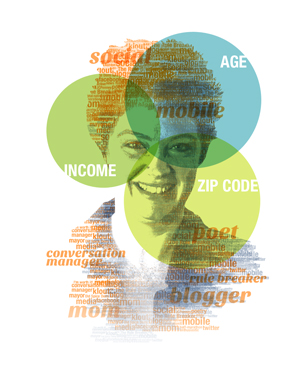Demographics Schmemographics: Who You Callin’ a Mother?
 Brands have a tough job defining and targeting customers. We sure don’t make it easy. Demographics like age, gender, race, religion, zip code, marital status and income help predict behaviors and interests, but there are exceptions to every rule. And don’t we all want to believe that we are the exception? The rule breaker?
Brands have a tough job defining and targeting customers. We sure don’t make it easy. Demographics like age, gender, race, religion, zip code, marital status and income help predict behaviors and interests, but there are exceptions to every rule. And don’t we all want to believe that we are the exception? The rule breaker?
For example, by definition I am a mommy blogger, but don’t you dare call me one. The category irks me. Or maybe the stereotype irks me. Most mommy bloggers I know don’t blog “just” about being mommies, and they certainly don’t blog about coupons or cleaning products. They blog about things like relationships, half-marathons and poetry, like I do (though I sometimes take weeks off between posts despite knowing better through my day job).
Do not refer to me as “soccer mom” or “hockey mom,” either, though my sons play both sports. You should also avoid “SAHM” (though I was one for a while) and “working mom” (duh, isn’t every mother? The President says so, anyway). Yes, what they say about people who assume is true, and mom stereotypes are old-school. I don’t drive a minivan or a humungous SUV. I don’t buy diapers, lunchmeat or fruit roll-ups. I don’t organize bake sales (who would dare to these days?) or hide in the bathroom for alone-time.
Age demographics are equally loaded. It makes me cranky that so-called “digital natives,” who are younger than I am, get all the attention. My Klout score qualifies me for exclusive lounge access in an airport terminal and extra matches in a Klout-based dating service, and I am the mayor of two restaurants in my urban neighborhood. (I offer these examples very tongue-in-cheek. They are the goofy part of my “social” life. I’ll never be at the VIP international terminal, and the mention of living downtown contradicts my argument about being different: I’m actually part of the trend of people leaving suburbs and heading for the city.)
So while I can’t text as efficiently as a digital native (how do they do that?), my mobile, social and media habits are closer to theirs than to my own Gen X. I don’t have a DVR, watch primetime TV or receive print newspaper delivery. I watch all my favorite shows online, and I get my news from the Web, very often via Twitter or my Facebook newsfeed.
In addition, in terms of age, I come somewhere between Demi and Ashton (though I am certainly not what came between them). Technically, I am closer in age to him, but feel a much deeper affinity with her. Is it a chick thing? No, it’s an “ex” thing. We’ve both recently changed our Twitter handles to expunge our married names (she was @mrskutcher but is now @justdemi).
Do gender assumptions otherwise pan out? Nope. I relate more to the edgy, stereotypically-male personas of J&P Cycles and Old Spice (I am a customer of neither) than I do jcpenney (where I am a customer).
I bet your profile, like mine, includes contradictions that baffle marketers who rely solely on demographic data. I contain multitudes, wrote Whitman. So what’s a marketer to do?
How about this? Get to know me as a person, not a stereotype. That’s the beauty of modern social marketing. With the right approach – a game, a loyalty program, a contest/promotion or a location-based offer – brands can earn my active (and often enthusiastic) participation in personalizing their marketing. It may be a little more complicated and require a little more creativity, but I’m totally worth it. My mom told me so.




